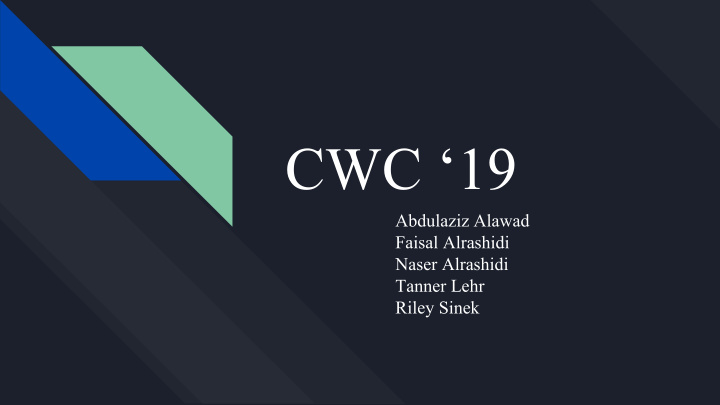



CWC ‘19 Abdulaziz Alawad Faisal Alrashidi Naser Alrashidi Tanner Lehr Riley Sinek
Project Description ● U.S. Department of Energy is our sponsor ● Collegiate Wind Competition- U.S. Department of Energy ○ Competition held in Boulder, Co May 13th-14th ○ Fifth team representing NAU at the Competition ○ Working with Electrical Engineering group Faisal 1
Black Box Model ● Main purpose of the turbine is to produce power ○ Result of harnessing the wind’s kinetic energy and converting it to electrical power Figure 1: Black Box Model 2 Riley
Hypothesized Functional Model ● Conversion from Kinetic Energy to Electrical Energy ● Complete Certain Tasks for Competition ● No human interaction during testing Figure 2: Hypothesized Functional Model 3 Riley
Concept Generation ● 5-4-5 method sketching (includes a few bio-inspired designs) ● Sketches done individually in own time Figure 3: Yaw Concept Generation Figure 4: Shaft Concept Generation 4 Riley
Blade Design Concepts ● Small blade: ○ Pros: Smaller amount of material, therefore easier to move ○ Cons: Not an optimum swept area ● Wide base: ○ Pros: Higher swept area, easier cut-in due to wide base ○ Cons: More material, will need more thrust to be propelled Figure 5: Small Blade Design 5 Figure 6: Wide Base Blade Design Riley
Nacelle Designs ● Side panels ○ Pros: Potential for yawing from nacelle ○ Cons: Less strong ● Hole design ○ Pros: Options for wire organization for electrical team ○ Cons: Crowded nacelle because of wires being directed towards front of design Figure 7: Side Panel Nacelle Design Figure 8: Hole Nacelle Design Riley 6
Tower Design Concepts ● Rolly Chair ○ Pros: Lighter than a baseplate ○ Cons: Not stable or fastenable to comp. mount ● CWC ‘18 ○ Pros: Sturdy design, can be fastened to mount ○ Cons: Strength over-designed, could be cheaper Figure 10: Round Tower Concept(CWC ‘18) Figure 9: Rolling Chair Tower Concept 7 Abdulaziz
Yaw Design Concepts ● Tower Yaw ○ Pros: Compact and durable ○ Cons: Inefficient yawing power, too little surface area ● Angled Pyramid Scheme ○ Pros: Compact, strong and high efficiency ○ Cons: Heavier than other potential yaws Figure 11: Tower Yaw Concept Figure 12: Pyramid Concept 8 Abdulaziz
Brake Design Concept ● Linear Actuator (CWC ‘18) ○ Pros: Compact, high stopping power ○ Cons: Poorly designed, high cost ● Stepper ○ Pros: Strong stopping power and accurate ○ Cons: Less compact Figure 13: Linear Actuator(CWC ‘18) Figure 14: Stepper Motor Concept 9 Abdulaziz
Shaft Design Concept ● Hollow Shaft Design ○ Pros: Weight reduction, easier to rotate ○ Cons: Smaller cross-sectional area (less durable) ● Thick Diameter Ends ○ Pros: Durable at concentrated stress points (Larger cross-section) ○ Cons: Heavier than necessary, higher stress concentration at diameter changes Figure 16: Thick Diameter Ends Concept Figure 15: Hollow Shaft Concept Abdulaziz 10
Pugh Chart - Blade ● Top 3 choices are Wide Base, Small Blade, and Betz Blade Table 1: Blade Concept Pugh Chart 11 Tanner
Pugh Chart - Yaw ● Top 3 choices are Pyramid(tip), Pyramid(separate), and Rough Surface Table 2: Yaw Concept Pugh Chart Tanner 12
Pugh Chart - Nacelle ● Top 3 choices are open front/back, hole, and side panels Table 3: Nacelle Concept Pugh Chart Tanner 13
Pugh Chart - Shaft ● Top 3 choices are hollow, polymer, CWC ‘18 Table 4: Shaft Concept Pugh Chart Tanner 14
Pugh Chart - Brakes ● Top 3 choices are CWC ‘18, dynamic, and stepper motor Table 5: Brake Concept Pugh Chart Tanner 15
Pugh Chart - Tower ● Top choice was CWC ‘18 tower design Table 6: Tower Concept Pugh Chart Tanner 16
Design Matrix - Blades ● The best design will have a wider base Table 7: Blade Decision Matrix Tanner 17
Decision Matrix - Yaw ● The best design will be the pyramid(separated tip) Table 8: Yaw Decision Matrix Tanner 18
Decision Matrix - Nacelle ● The best design will be the open nacelle with a hole in the bottom Table 9: Nacelle Decision Matrix Tanner 19
Decision Matrix - Shaft ● The best design will be similar to CWC’18 design Table 10: Shaft Decision Matrix Tanner 20
Decision Matrix - Brakes ● The best design will be using a stepper motor to initiate braking Table 11: Brake Design Decision Matrix Tanner 21
Decision Selection ● Based on Pugh Chart and Decision Matrix the best designs are: Blade Yaw Nacelle Shaft Brake Tower Wide Base Pyramid Open with CWC ‘18 Stepper CWC ‘18 (Separated Tip) access hole (Similar Design) Motor (Similar Design) ● All designs fit into criteria given by Department of Energy Tanner 22
Schedule ● Used Gantt project template in Excel ● Current position - catching up to original schedule still, but further caught up than before Table 12: Gantt Chart Project Schedule Naser 23
Budget ● Summary of costs and anticipated costs throughout the project Table 13: Project Budget sheet Naser 24
Questions ? 25
References [1]Ace Energy. (2018). Us Department Of Energy Logo - Ace Energy . [online] Available at: http://en.stonkcash.com/us-department-of-energy-logo/ [Accessed 15 Oct. 2018]. [2]Northern Arizona University, "NAU Collegiate Wind Competition 2017-2018," U.S. Department of Energy, Flagstaff, 2018. 26
Recommend
More recommend